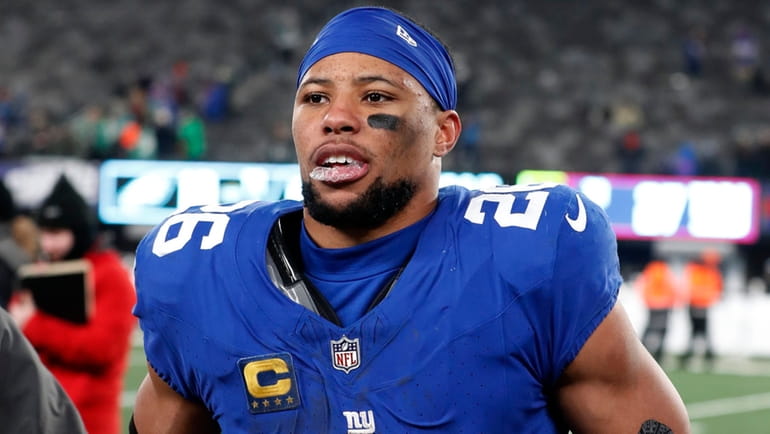2024 NFL salary cap inflates only prices, not plans for Giants, Jets

Saquon Barkley of the New York Giants. Credit: Jim McIsaac
Citing an “extraordinary increase in media revenue” along with “the full repayment of all amounts advanced by the clubs and deferred by the players during the COVID pandemic,” the NFL announced on Friday that the 2024 cap will be set at $255.4 million per team, an increase of $30.6 million over the previous year.
Most teams were operating under a projected 2024 cap somewhere between $242 million and $250 million. The actual numbers blew away those estimates.
While the value of the 2024 increase is the highest ever — the jump is nearly equal to the entire salary cap in 1994, when each team had $34.6 million to work with — it represents the fourth-largest percentage increase at 13.61%.
Just two years ago, it went up 14.08%, but that was mostly to compensate for the $15.7 million by which it had decreased in 2021 to account for the pandemic year. The biggest percentage increase was in 1998, when the cap rose by 26.38% to $52.3 million; that too was a direct result of new broadcast deals.
Eye-popping as the new NFL salary-cap numbers are, don’t expect them to have a massive immediate impact on the Giants or Jets or spur any previously unexpected franchise-altering spending sprees in the coming months.
The most obvious takeaway from the windfall is that all teams will have more money to spend in free agency, which officially begins with a two-day negotiating period starting March 11 before the start of the new league year on March 13. According to OverTheCap.com, the Giants will have about $30.8 million at their disposal and the Jets will have about half of that after making some expected cuts. Those numbers can go up or down depending on what happens in the next few weeks.
While the Giants’ cap space may seem significant, 15 teams currently expect to have more and at least six will have more than double the amount. The Commanders have a league-high $79.6 million in projected cap space.
Because all 32 teams are receiving the same boon, there is barely any competitive advantage for the Giants in this free- agency period from having all of those available funds. They were going to be spenders wherever the cap landed; it was just a matter of whether they would have $10 million or $20 million or their current $30 million in free space.
All the new cap number did for them was raise the cost for many of the players on their shopping list (not to mention add a few other teams that might have otherwise been cap-restricted into the mix for those contracts).
Several positions should see significant jumps that reset salary expectations, including, perhaps, those of running backs, whose contracts have lagged in recent years but who will represent some of the highest-profile free agents next month. Saquon Barkley could be among those free agents unless the Giants decide to use part of their newfound space to help bridge a negotiating gap between the two sides.
The biggest benefit for the Giants comes in more subtle — but not necessarily less significant — areas.
Their existing contracts with players such as Andrew Thomas, Dexter Lawrence and Daniel Jones now represent a much smaller percentage of the current cap (36.2). Thomas is under contract through 2029, by which time his $22.9 million cap hit for that season may seem like loose change for a parking meter compared to the cost of other top-tier offensive tackles. As for Jones, his $47.1 million cap number eats up nearly a fifth of the entire number in 2024 (18.4%), but the $22.2 million in dead-cap charges the Giants would be saddled with if they trade or release him in 2025 is much more manageable when it is a smaller portion of the whole. That could push them closer toward drafting or otherwise acquiring an eventual replacement for Jones this spring.
The new salary cap also set the franchise and transition tag numbers for 2024. For the Giants, who are mulling both of those for safety Xavier McKinney, it could tie him to the team for 2024 at $17.1 million (franchise) or $13.8 million (transition). The two tags allow players to negotiate with other clubs and gives the team a chance to match any deal. The main difference between the two is that the team receives draft pick compensation if the player ultimately signs elsewhere under the franchise tag and receives nothing under the transition tag. If the Giants wind up keeping McKinney at $13.8 million, it would be a bargain.
As for the Jets and their $15 million or so in expected cap space (they may be able to create more with some restructures of existing deals), it could change their approach toward their biggest pending free agent, edge rusher Bryce Huff. The franchise tag of $21.3 million for his position still would be quite high for a situational player (he would have the second-highest cap hit on the team in 2024), but the space gives them a better chance to reach an extension with Huff before he gets to free agency. It also decreases the likelihood that defensive lineman John Franklin-Myers will become a “cap casualty” with his $16.364 million hit for 2024.
Business is booming. That’s good news for everyone. It’s good for the players. It’s good for the Giants and Jets. It’s good for 30 other teams, too.
But it has very little correlation with the actual product around here, which has been in a downturn for a long time.
Those two bottom lines — the football one and the financial one — are only vaguely related.

